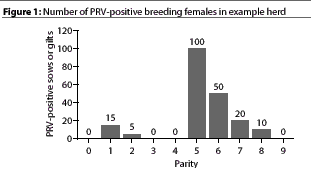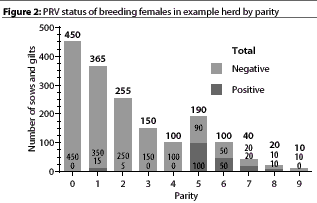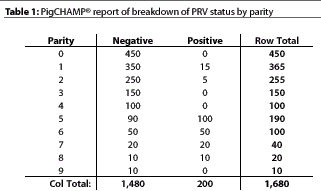 WHAT'S YOUR INTERPRETATION?
WHAT'S YOUR INTERPRETATION?
 This figure shows the number of
pseudorabies virus- (Aujeszky's disease-) positive animals in
a herd by parity distribution. This 1600-sow herd had been purchasing
PRV-negative gilts for 1 year, and double vaccinating them in
an offsite isolation unit prior to introducing them into the herd.
Gilts are blood tested before leaving isolation to be sure they
are PRV negative. Currently the entire sow herd is being vaccinated
on a quarterly basis.
This figure shows the number of
pseudorabies virus- (Aujeszky's disease-) positive animals in
a herd by parity distribution. This 1600-sow herd had been purchasing
PRV-negative gilts for 1 year, and double vaccinating them in
an offsite isolation unit prior to introducing them into the herd.
Gilts are blood tested before leaving isolation to be sure they
are PRV negative. Currently the entire sow herd is being vaccinated
on a quarterly basis.
What can you tell from this figure about the effectiveness
of the vaccination/eradication program? For the 5 months prior
to generating the report that resulted in Figure 1 (front cover,
and repeated here), all sows in the farrowing house had been blood
tested for PRV with the intention of culling all positive sows
at weaning. Unfortunately, there were several weeks in a row when
> 75% of the sows in any given week came back PRV-positive.
To meet breeding targets, some positive sows had to be rebred.
For the 5 months prior
to generating the report that resulted in Figure 1 (front cover,
and repeated here), all sows in the farrowing house had been blood
tested for PRV with the intention of culling all positive sows
at weaning. Unfortunately, there were several weeks in a row when
> 75% of the sows in any given week came back PRV-positive.
To meet breeding targets, some positive sows had to be rebred.
Using a herd records database such as PigCHAMP(R), it is possible
to effectively track PRV-positive animals in a herd. As you can
see from Figure 1, this herd has a number of animals that are
PRV-positive in parities >= 5. It also appears that there are
some PRV-positive animals in parities one and two.  From
Figure 2, you can see the overall parity distribution of the herd
compared to the PRV-positive distribution.
From
Figure 2, you can see the overall parity distribution of the herd
compared to the PRV-positive distribution.
Our clinic uses the PigCHAMP(R) "USER1" location under
sow records Æ record details to code in positive or negative
PRV test results on the individual animals when the results come
back from the lab. We have found this especially beneficial during
the eradication process to follow sows that were tested during
gestation and were suppose to be removed postweaning.
This "USER1" ID is an excellent way to keep track of
positive animals throughout subsequent gestations and farrowings
to make sure that they eventually get removed. It can also be
used to track seroconversion rates of animals that go from negative
to positive and to make sure that incoming gilts were staying
negative. For example, as Figure 1 shows, midway through the eradication
process in this example herd, a majority of younger animals were
remaining seronegative while there were still seropositive animals
in the older parities. Eventually we were able to remove these
positive animals and eradicate PRV from this herd. The sows' parity,
location, and removal information was already being tracked through
the PigCHAMP(R) system. We were also able to generate lists of
positive animals by using the List Data function under Database
Applications using USER1= "Positive" as the filter.
We were also able to get the entire herd picture by using the
Report Type.....Break Down with the Row Cross tabulation variable
as parity and the column cross tabulation variable as User1  (Table 1). This system could also be beneficial
for monitoring the eradication of other diseases, such as porcine
reproductive and respiratory syndrome virus (PRRSV).
(Table 1). This system could also be beneficial
for monitoring the eradication of other diseases, such as porcine
reproductive and respiratory syndrome virus (PRRSV).
The weakness of the system is that on occasion animals with lost
tags get coded back in as "Parity 1" animals when they
are retagged in the farrowing house. This makes it appear that
you have seroconversion occurring in younger animals when in reality
it is just older animals that are seropositive. This was the case
in the above example: the parity-one and parity-two positive females
were misidentified by parity.
